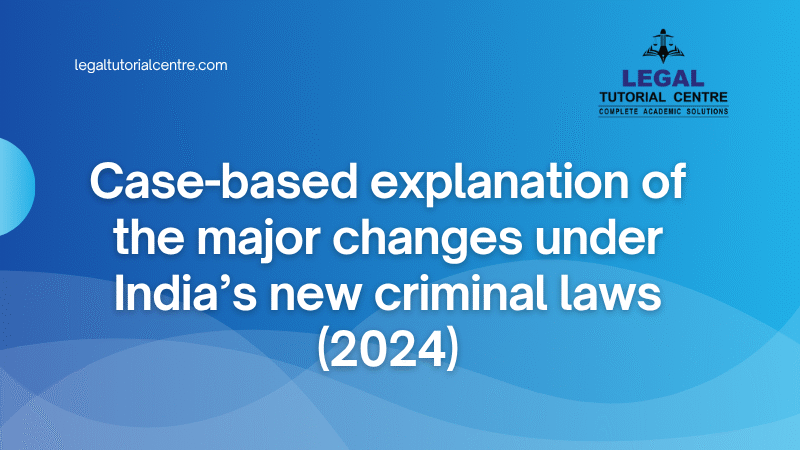1. Mob Lynching – Section 103 BNS
Provision:
Under Section 103 of BNS, if a group of 5 or more persons commits murder based on identity factors like caste, religion, etc., it is treated as mob lynching. Punishment can be life imprisonment or death.
Case-Based Example:
Imagine in a village, 7 people beat a man to death suspecting him of carrying beef. Under IPC, they were charged with murder. Under BNS 2023, this would specifically fall under mob lynching, bringing harsher punishment due to the identity-based motive.
Impact:
This shows the intent to tackle hate crimes more specifically, unlike IPC which had no clear category for mob violence.
2. Forensic Investigation Mandatory – Section 176(3) BNSS
Provision:
For offences punishable with ≥7 years, forensic evidence (DNA, fingerprints, etc.) is mandatory.
Case-Based Example:
In a rape and murder case, earlier, the conviction heavily depended on the victim’s statement and witness evidence. Now under BNSS, forensic labs must collect DNA samples, and failure to do so can weaken the case or be considered a violation.
Impact:
This ensures scientific evidence is not optional, making the investigation more reliable and tamper-proof.
3. E-FIR and Zero FIR – Section 173 BNSS
Provision:
FIRs can be filed electronically, from any police station (zero FIR), and must be signed within 3 days.
Case-Based Example:
A woman is harassed on a train journey between Mumbai and Bhopal. Earlier, she had to report to the jurisdictional police station. Now, she can lodge a Zero FIR at any station or via email, and it will be transferred to the correct jurisdiction.
Impact:
This removes delays and jurisdictional hurdles, especially in gender-based crimes or during inter-state travel.
4. Snatching – Section 304 BNS
Provision:
Snatching is now defined separately and punishable by 3 years imprisonment and fine.
Case-Based Example:
Suppose a man riding a bike snatches a woman’s mobile phone while she’s on a call. Earlier, this was prosecuted under “theft” or “robbery” which made the case confusing. Under BNS, this is clearly classified as ‘snatching’, streamlining prosecution.
Impact:
Provides clear categorisation for crimes that had legal ambiguity earlier.
5. Community Service – New Form of Punishment (Section 4 BNS)
Provision:
Judges can now order community service as punishment for minor offences.
Case-Based Example:
A man is caught defacing a public wall with graffiti. Instead of jail time, the court may order him to clean public spaces or participate in civic duties for 15 days.
Impact:
Promotes restorative justice and decongests prisons, while ensuring public accountability.
- Electronic Evidence – BSA 2023
Provision:
Digital records (WhatsApp, emails, CCTV) are fully admissible if authenticated.
Case-Based Example:
In a fraud case, screenshots of bank chats and CCTV footage showing the accused at an ATM during the crime are submitted. Under the old Evidence Act, proving authenticity was tedious. Under BSA, Section 63 provides clear guidelines on how to submit e-evidence with certificates.
Impact:
This is crucial in a digital age, making cases easier to prove and reducing the risk of tampering.
7. Trial in Absentia – Section 356 BNSS
Provision:
If the accused willfully absconds, the court can conduct the trial in their absence.
Case-Based Example:
A man accused of human trafficking escapes abroad and avoids appearing despite repeated summons. Under IPC/CrPC, the trial could not proceed. Under BNSS, the trial continues without him, and conviction can happen.
Impact:
Reduces delays, ensures justice is not denied due to accused being absconding.
Conclusion
The new criminal laws of 2024 — Bharatiya Nyaya Sanhita, Bharatiya Nagarik Suraksha Sanhita, and Bharatiya Sakshya Adhiniyam — mark a significant shift in India’s criminal justice system. They aim to modernize legal provisions by introducing clearer definitions, faster trial procedures, digital integration (like e-FIR and electronic evidence), and stronger victim protection mechanisms.
Key reforms such as recognising mob lynching, mandatory forensic investigation, separate classification of snatching, and the introduction of community service as punishment reflect a more structured and progressive approach. Additionally, the inclusion of electronic evidence and trial in absentia aligns the system with current societal and technological realities.
While the intent is to make justice more efficient and victim-centric, successful implementation will depend on adequate infrastructure, training, and protection of constitutional rights. These laws represent a step toward a more responsive and accountable legal framework in India.


